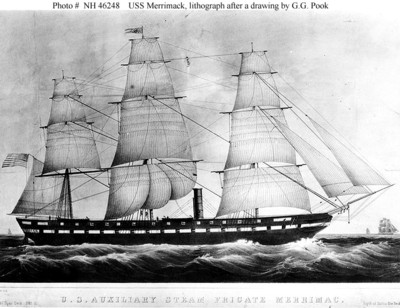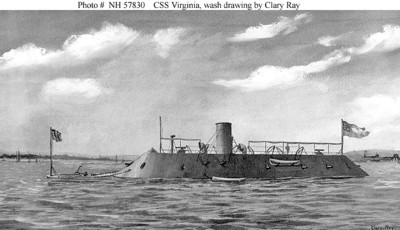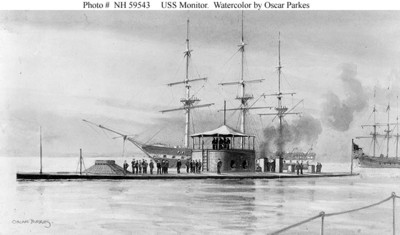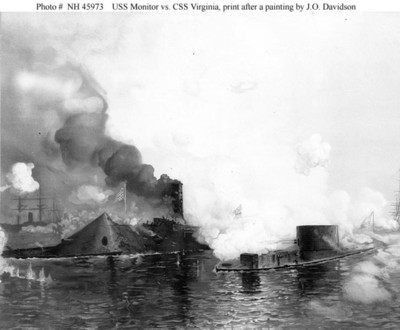Travel into Virginia's past with Ghost Guns Virginia
| |
|
|
|
|
|
|
|
|
Support Ghost Guns
|
The Battle Between the Monitor and the Virginia, a summary by Joseph Umberto The battle between the USS Monitor and the CSS Virginia is one of the most famous naval battles of all time and certainly the most famous that ever took place in Virginia! Below is one of several articles that will be forthcoming on the Battle of Hampton Roads.
The Merrimack remained in Norfolk, and was there when the state of Virginia seceded from the Union on 17 April 1861. Federal forces sank the Merrimack on 20 April as they withdrew from the Norfolk Navy Yard in an effort to make her unusable to the southern cause. When the Confederate States Navy arrived at Norfolk Navy Yard they found the Merrimack burned to the waterline and sunk, but the shipís lower hull and machinery were intact, engineers salvaged the ship and converted her to an armored casemate ironclad. Ironclad warships were a new concept in warship design that both the Union and Confederate Navy were interested in. A casemate ironclad is an iron-armored gunboat that consisted of a low cut hull with little freeboard. Compared to the traditional ironclads it does not have its cannons in a rotating armored gun deck, but in a sloped-casemate structure that is constructed on the main deck where the guns are housed. The guns are fired from fixed gun ports housed in the casemate. The Confederate State Navy would adopt a variance of this design.
Hampton Roads was the scene of an epic naval battle on 9 March 1862. This was the first battle between two ironclad ships; it is perhaps the most significant naval battle of the entire Civil War. The Battle of Hampton Roads unfolded on 8 March when the Virginia set sail for Hampton Roads. The Patrick Henry, Jamestown, Teaser, Raleigh, and Beaufort accompanied the Virginia to take on the Union blockade. The blockade strategy had been a success for the Union. The Confederacy had a difficult time engaging in overseas trade or re-supply of its forces through its ports due to this stranglehold. The first ship that was encountered was the USS Cumberland. The Cumberland was sunk after being rammed by the Virginia. When sinking the Cumberland the iron ram broke off from the Virginiaís bow. Seeing what happened to Cumberland, the captain of the USS Congress ordered his ship grounded in shallow water. The Congress and Virginia traded fire for about an hour, after which the badly-damaged Congress surrendered. A Union battery on the north shore opened fire on Virginia while the surviing crewmen of the Congress were being ferried off the ship. In retaliation, the captain of Virginia ordered Congress fired upon with red-hot shot that set her ablaze. The Virginia did not emerge from the battle unscathed. Shot from Cumberland, Congress, and Union troops on shore had riddled her smokestack, reducing her already low speed. The Virginia's best speed was about 9 knots. The weight of the iron and poor steam engine performance was a known problem. Now two of her guns were out of order, and a number of armor plates had been loosened. Regardless of the damage report, her captain attacked the USS Minnesota, which had run aground on a sandbank trying to escape the Virginia . Virginia was unable to do significant damage because of her deep draft. Her draft prevented her from closing and engaging the Minnesota. It being late in the day, Virginia broke off the engagement with the expectation of returning the next day and completing the destruction of a Union fleet now in havoc.
The next day, on 9 March 1862, the world's first battle between ironclad warships took place, thus making all wooden ships in the Navies of the world obsolete. The smaller and nimbler Monitor was able to out-maneuver the Virginia , but neither ship proved able to do significant damage to the other although both were damaged. The Monitor was much closer to the water, so apart from the reinforced turret it was difficult for Virginia's guns to hit her, but the Monitor was vulnerable to ramming and boarding. Finally, with her captain injured the Monitor retreated and the CSS Virginia claimed the day. Controversy over who actually won the battle continues to this day, however.
Several parts of the Virginia survive in museums, including dented armor and the ship's wheel at the Mariners' Museum in Newport News, and an anchor and part of a propeller shaft at the Museum of the Confederacy in Richmond. The Virginia Department of Historic Resources has called for a follow-up investigation to decide if the wreck spotted in a 2003 survey near Craney Island is the Virginia. If it is, federal and state laws require that the ship's remains be removed before any dredging can take place. The Monitor, not suitable for ocean travel either, was being towed down the coast in late 1862 and sank in heavy seas; she landed upside down in 240 feet of water, 16 miles off Cape Hatteras, North Carolina. 16 members of her crew were lost, the rest made it to safety in the tug boat. A joint US Navy and National Oceanic and Atmospheric Administration team has raised the Monitor's turret and other parts. The Mariners' Museum in Newport News has custody of Monitor artifacts. The USS Monitor Center at the Marinersí Museum is on schedule to open 9 March 2007. The greatest lesson learned from this battle was the importance of technology to warfare. The Virginia's sinking of two wooden vessels on 8 March and the technological superiority of the Monitor's iron revolving turret in effect sank all of the world's wooden navies. Iron now ruled supreme across the seven seas.
The Webography All photos are from the copyright-free archives of the US government. |
. |
Our other website is out of this world:
 The USS Merrimack, which will become the CSS Virginia
The USS Merrimack, which will become the CSS Virginia
 The USS Merrimack, which will become the CSS Virginia
The USS Merrimack, which will become the CSS Virginia  The USS Monitor, savior of the Union fleet in Hampton Roads
The USS Monitor, savior of the Union fleet in Hampton Roads The USS Monitor versus the CSS Virginia
The USS Monitor versus the CSS Virginia